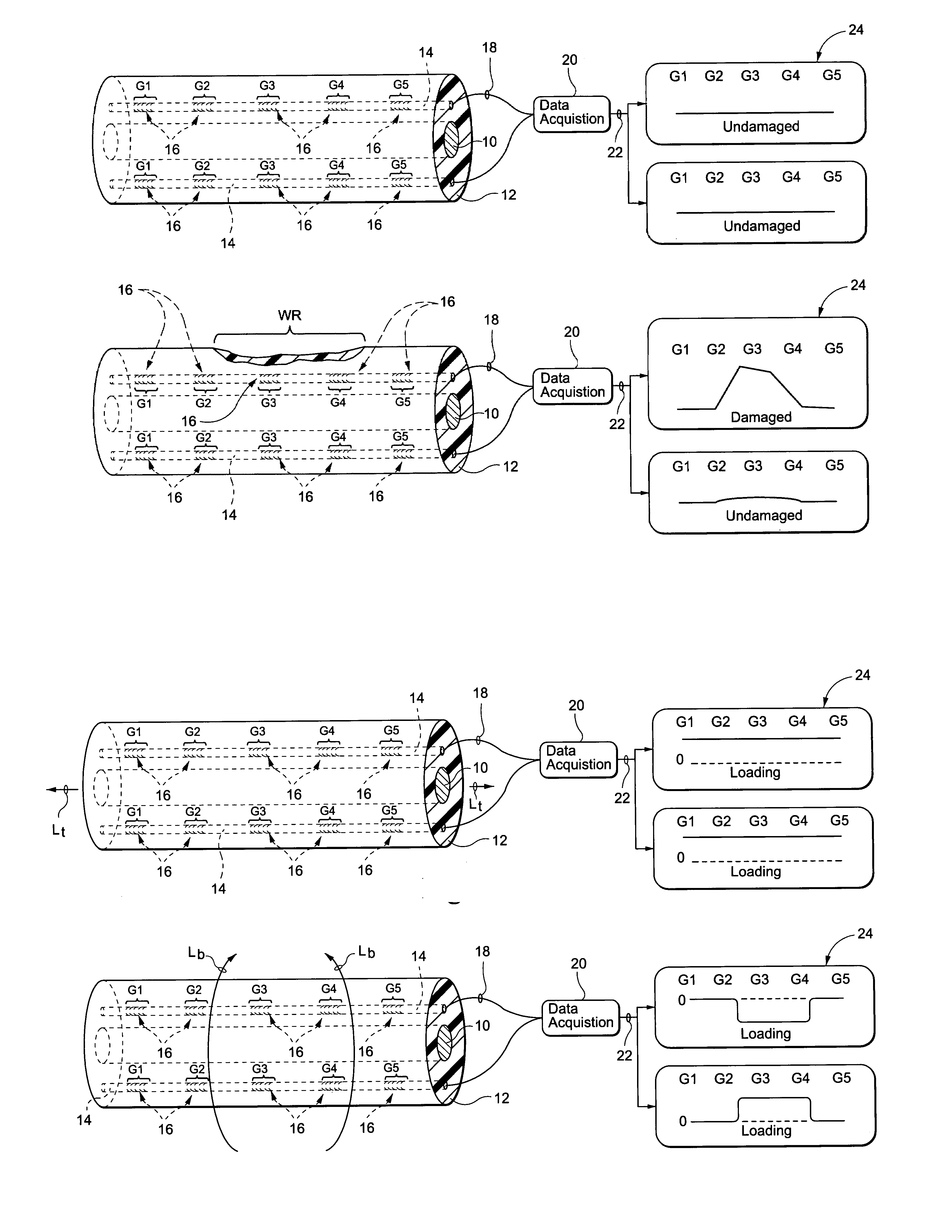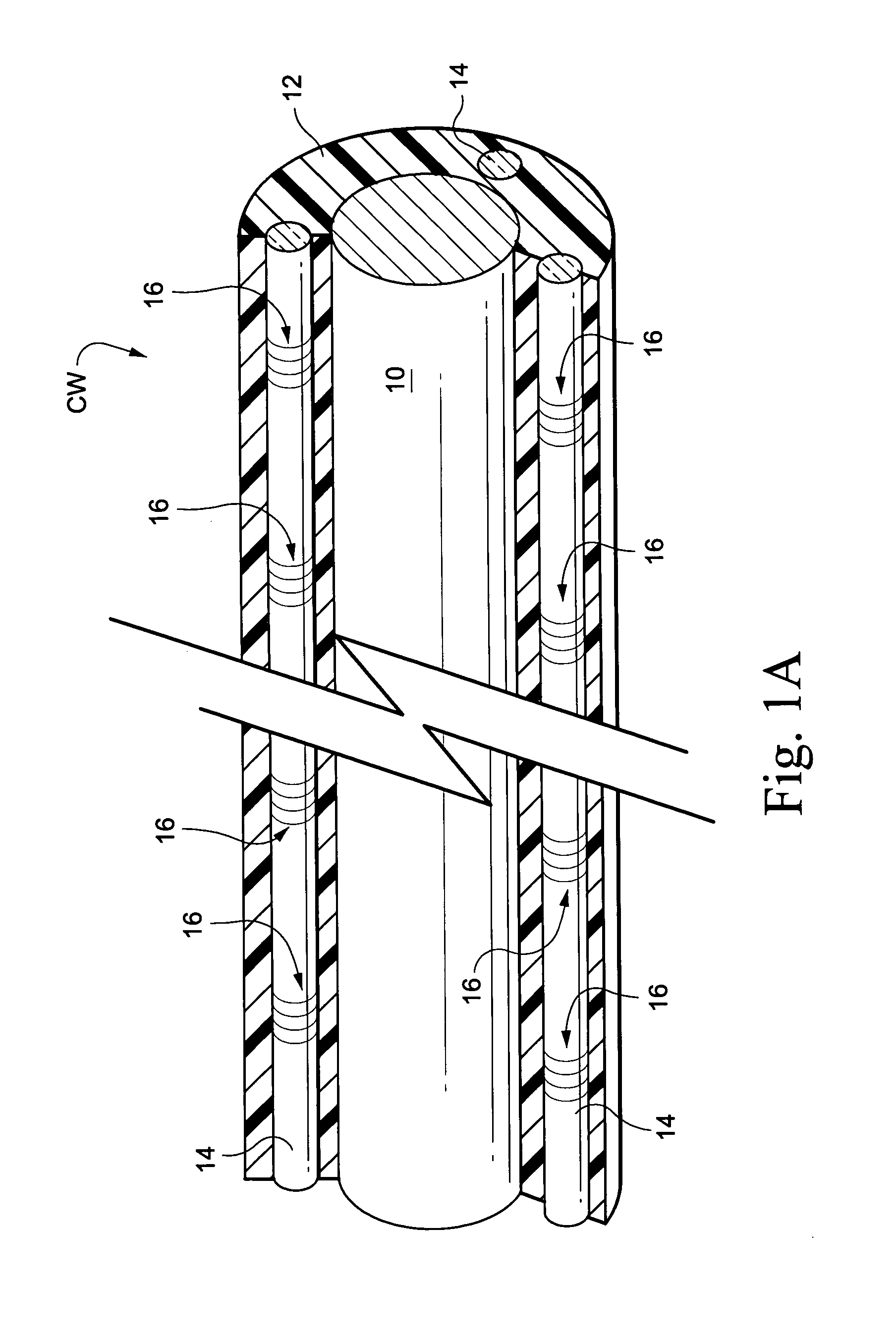Composite structures, such as coated wiring assemblies, having integral fiber optic-based condition detectors and systems which employ the same
a technology of condition detector and composite structure, applied in the field of fiber optic condition detection, can solve the problems of human error and inconsistency, difficulty in detecting ground faults and arcings, and inaccessible visual inspection, etc., and achieve the effects of enhancing the detection of tensile, bending and pinching loads, reducing the compressive strain of fiber optic sensors, and facilitating thermal compensation
- Summary
- Abstract
- Description
- Claims
- Application Information
AI Technical Summary
Benefits of technology
Problems solved by technology
Method used
Image
Examples
example 1
[0064]Residual stresses were produced between an insulating polyolefin tube and an optical fiber sensor. Wire insulation was simulated by semi-rigid adhesively lined polyolefin heat shrink tubing (3M Corporation). Initial wire insulation tests were conducted using the FiberPro™ system (Luna Innovations) to monitor single optical fiber Bragg gratings. The fiber was cleaned with isopropyl alcohol and then a thin coating of cyanoacrylate adhesive was applied to promote adhesion between the fiber and the polyolefin tubing. The fiber grating was then placed into the adhesively lined polyolefin tubing. A heat gun was used to shrink the tubing and melt the thermoplastic adhesive lining. At the peak temperature, the tubing was compressed to push entrapped air out of the tube and fully wet the fiber with the thermoplastic adhesive. The Bragg grating reflected peak position was continually monitored with the FiberPro system during the application and cooling of the polyolefin tubing.
[0065]The...
example 2
[0066]Residual stresses were produced between a polymer coating and an optical fiber sensor. Coatings were prepared using a polymer matrix containing a range of particulate additives including TERFENOL-D powder from Etrema Products, Inc. and iron fines. The particulate were approximately 25% volume fraction of the coating system. The TERFENOL-D powder particle sizes were less than 300 μm. The iron powder had a particle size less than 40 mesh (425 μm).
[0067]Optical fiber sensors including Bragg gratings (commercially available from Luna Innovations, Inc.) were coated with Spurr Low-Viscosity Embedding Media a four-part epoxy from Polysciences, Inc. This epoxy was used as the matrix material for these coatings. The approximately 2 mm thick coatings were cured at 70° C. for 16 hours. The total change in the reflected wavelengths of the coated optical fiber sensors were recorded for the four part epoxy with iron fines and TERFANOL-D particles. The reflected wavelength decreased by 1.5 t...
example 3
[0068]Wear tests were performed by mounting the polyolefin tube and Bragg sensor assembly described in Example 1 in a metallographic epoxy mount which was cast in a cylindrical mold. A V-shaped groove was machined into the mount and the fiber Bragg grating in the polyolefin tube was placed into the groove. A five minute epoxy was used to fill in the groove around the damage sensor. Silicon carbide 180 grit abrasive paper was used to generate flat parallel surfaces on both ends of the metallographic mount. All grinding was performed using deionized water as a lubricant to minimize heating of the sample. The face of the mount containing the insulation damage sensor was ground down to expose the polyolefin tube. Digital calipers were used to measure the thickness of the mount. To minimize temperature effects, the mount was placed in 500 ml of deionized water at room temperature. Once the mount equilibrated with the water temperature, the reflected Bragg peak position (wavelength) was r...
PUM
 Login to View More
Login to View More Abstract
Description
Claims
Application Information
 Login to View More
Login to View More - R&D
- Intellectual Property
- Life Sciences
- Materials
- Tech Scout
- Unparalleled Data Quality
- Higher Quality Content
- 60% Fewer Hallucinations
Browse by: Latest US Patents, China's latest patents, Technical Efficacy Thesaurus, Application Domain, Technology Topic, Popular Technical Reports.
© 2025 PatSnap. All rights reserved.Legal|Privacy policy|Modern Slavery Act Transparency Statement|Sitemap|About US| Contact US: help@patsnap.com



